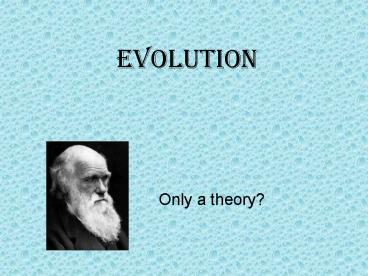Evolution - PowerPoint PPT Presentation
1 / 26
Title:
Evolution
Description:
Evolution Only a theory? Basic premises for this discussion Evolution is not a belief system. It is a scientific concept. ... (differential reproductive success) ... – PowerPoint PPT presentation
Number of Views:489
Avg rating:3.0/5.0
Title: Evolution
1
Evolution
- Only a theory?
2
Basic premises for this discussion
- Evolution is not a belief system. It is a
scientific concept. It has no role in defining
religion or religious beliefs - Evolution is a theorybut you dont get any
better than that in science - There is a lot of contention about evolution, but
not among scientists or scientific organizations.
3
Some basic definitions
- Fact an observation that has been repeatedly
confirmed - Law a descriptive generalization about how the
physical world behaves - Hypothesis a testable statement that can be used
to build inferences and explanations
4
Some basic definitions
- Theory a well-substantiated explanation that
incorporates facts, laws, inferences and tested
hypotheses.
In science, you dont get any better than a
theory.
5
What is evolution?
A basic definition of evolution
evolution can be precisely defined as any
change in the frequency of alleles within a gene
pool from one generation to the next." - Helena
Curtis and N. Sue Barnes, Biology, 5th ed. 1989
Worth Publishers, p.974
6
So what does the definition mean?
- Evolution is a change in the number of times
specific genes that code for specific
characteristics occur within an interbreeding
population - Individuals dont evolve, populations do
- There is no implied improvement in evolution
7
Another way to define it
- A process in which heritable characteristics of
a population accumulate over time
8
Evolutions Core Principles
Descent with modification
9
Evolutions Core Principles
- Natural Selection
- (differential reproductive success)
10
Evolutions Core Principles
- Evolutionary adaptations
- a prevalence of inherited characteristics that
enhance organisms survival and reproduction
11
Natural Selection Affects IndividualsEvolution
Affects Populations
12
Darwin did not work in a vacuum
13
Darwins Voyage of Discovery
A reconstruction of the HMS Beagle sailing off
Patagonia.
14
The Voyage of the Beagle
15
Darwins Observations and Inferences
- 1st Observation
- All species have such great potential fertility
that their population size would increase
exponentially if all individuals that are born
reproduced successfully.
16
Darwins Observations continued
- 2nd Observation
- Populations tend to remain stable in size,
excepting seasonal fluctuations. - 3rd Observation
- Environmental resources are limited
17
Darwins Observations continued
- 4th Observation
- Individuals of a population vary extensively in
their characteristics no two individuals are
exactly alike. - 5th Observation
- Much of this variation
- is heritable.
18
Darwins Inferences
- Inference 1
- Production of more individuals than the
environment can support leads to a struggle for
existence among individuals of a population, with
only a fraction of offspring surviving each
generation.
19
Darwins Inferences
- Inference 2
- Survival in the struggle for existence is not
random, but depends in part on the hereditary
constitution of the individuals. Those
individuals whose inherited traits best fit them
to their environments are likely to leave more
offspring than less fit individuals.
20
Darwins Inferences
- Inference 3
- This unequal ability of individuals to survive
and reproduce will lead to a gradual change in a
population with favorable characteristics
accumulating over the generations.
21
Evolution evidence Biogeography
- Geographical distribution of species
- Examples Islands vs. Mainland
- Australia Continents
22
Evolution evidence The Fossil Record
- Succession of forms over time
- Transitional links
- Vertebrate descent
23
Evolution evidence Comparative Anatomy
- Homologous structures (homology)
- Descent from a common ancestor
- Vestigial organs Ex whale/snake
hindlimbs wings on flightless birds
24
Evolution evidence Comparative Embryology
- Pharyngeal pouches, tails as embryos
25
Evolution evidence Molecular Biology
- Similarities in DNA,
- proteins and genes
- Common genetic
- code
26
- Absence of evidence is not evidence of absence.
- Carl Sagan































